Stable polypeptide formulations
a polypeptide and stable technology, applied in the field of diseases and diseases, can solve the problems of structural and functional instability, loss of efficacy and risk of adverse side effects, and decrease of effective concentration for a given administration
- Summary
- Abstract
- Description
- Claims
- Application Information
AI Technical Summary
Benefits of technology
Problems solved by technology
Method used
Image
Examples
example i
Polypeptide Stability Characterization in Buffered Solutions
[0147]This Example describes the characterization of various formulations on the stability of panitumumab. Also described is the characterization of various formulations on the long term stability of panitumumab bulk preparations.
[0148]A variety of formulation conditions that stabilize monoclonal IgG2 antibody panitumumab are described below. These formulation conditions include those applicable for administration of the therapeutic polypeptide as well as for the storage, maintenance and / or lot preparation of the therapeutic polypeptide. The formulation conditions of the invention exemplified below confer particularly useful panitumumab stability against aggregation, chemical degradation and particle formation. These conditions were shown to be particularly effective in preventing particle formation which allows elimination of any need for in-line filter for intravenous administration.
[0149]Briefly, panitumumab was found to...
example ii
Stable Liquid Formulations Reducing Isoaspartic Acid Formation
[0249]This Example describes the use of the divalent cation calcium chloride (CaCl2) to increase stability of panitumumab in a liquid formulation.
[0250]The aspartic acid residue in CDR3 of the anti-EGFR antibody panitumumab is in a flexible, solvent exposed beta-turn and was used as an exemplary polypeptide to demonstrate divalent cation inhibition of aspartic acid isomerization. This aspartyl residue also does not appear to be in network with other secondary structures and is available to interact with solvent and divalent metal ions. As described further below, inclusion of a divalent metal such as CaCl2 in a polypeptide formulation slowed the succinimide intermediate kinetics and stabilized the polypeptide structure. The base formulation used to assess any effects of divalent cations on polypeptide stability was 10 mM sodium acetate, 2.6% glycerol, 0.004% polysorbate 80, pH5.0 at 20 mg / mL polypeptide and varying amount...
PUM
| Property | Measurement | Unit |
|---|---|---|
| Fraction | aaaaa | aaaaa |
| Fraction | aaaaa | aaaaa |
| Fraction | aaaaa | aaaaa |
Abstract
Description
Claims
Application Information
 Login to View More
Login to View More - R&D
- Intellectual Property
- Life Sciences
- Materials
- Tech Scout
- Unparalleled Data Quality
- Higher Quality Content
- 60% Fewer Hallucinations
Browse by: Latest US Patents, China's latest patents, Technical Efficacy Thesaurus, Application Domain, Technology Topic, Popular Technical Reports.
© 2025 PatSnap. All rights reserved.Legal|Privacy policy|Modern Slavery Act Transparency Statement|Sitemap|About US| Contact US: help@patsnap.com



